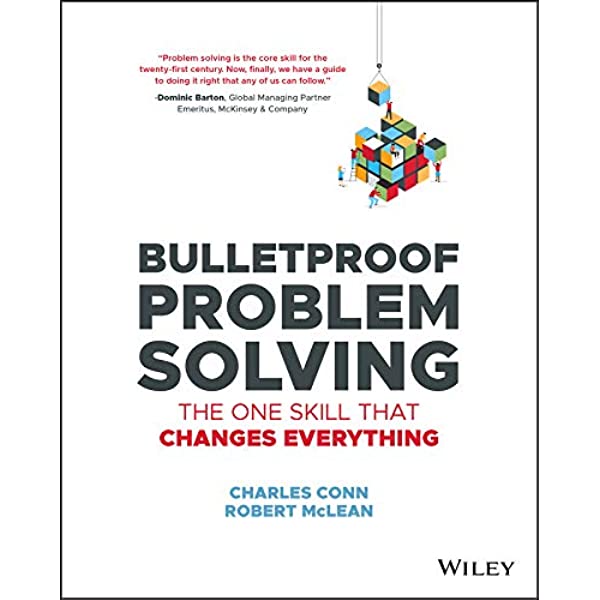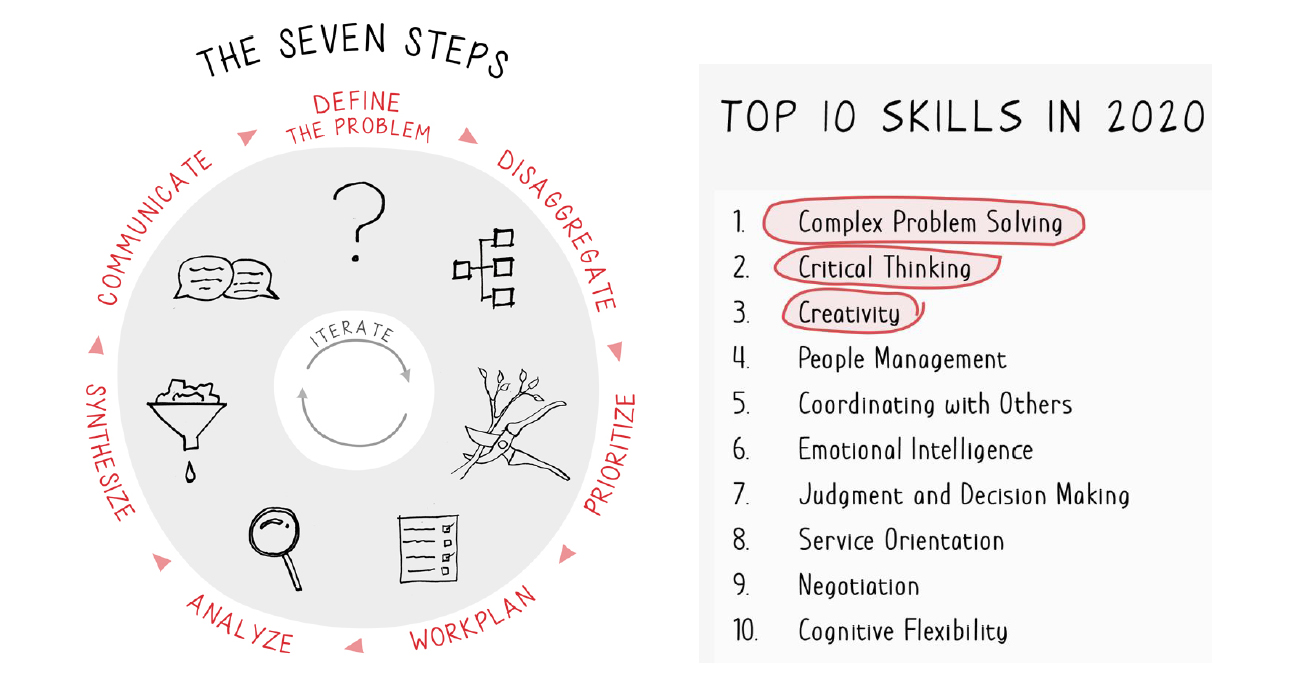18 03 2023 at 09:03
Bulletproof Problem Solving: The One Skill that Changes Everything
 Rob McLean AM
Rob McLean AM
Rob is a Director Emeritus of McKinsey and Company. He led the Australian and New Zealand McKinsey practice for eight years and served on the firm’s global Director’s Committee. As Dean of the Australian Graduate School of Management (AGSM), Rob saw the growing need for stronger problem-solving capability for business leaders of the future. He is now an investor in mathematics education and data analytics software, alongside his philanthropic interests in conservation and social enterprise. He employs these techniques in his role as a Trustee of The Nature Conservancy in Australia and Asia to address water for wetlands, shellfish restoration and improving human health from urban green spaces. He is a director of the Paul Ramsay Foundation, Australia’s largest philanthropic Foundation. He is a graduate of the University of New England in Australia and the Columbia University Graduate School of Business. He became a member of the Order of Australia in 2010 for his contributions to business, social welfare, and the environment.
Charles Conn
Charles Conn is a seasoned cross-sector leader and entrepreneur. Charles is an experienced investor, and is co-founder and CEO of Monograph Capital, a life sciences venture firm based in London and San Francisco. Before that, he was CEO of Oxford Sciences, a £600m venture firm formed in partnership with Oxford to develop the University’s advanced science ideas. Charles has been a technology entrepreneur, and as founding CEO of Ticketmaster-Citysearch led the company through its IPO (NASDAQ TMCS) and acquisitions of Match.com, Evite, and other companies. He is also a nonprofit education and conservation leader, including a five-year term as CEO of the Rhodes Trust, the organization that delivers the Rhodes Scholarships in Oxford. Earlier, Charles was senior advisor to the Gordon & Betty Moore Foundation, he sits or has sat on many company and nonprofit boards, including Patagonia and The Nature Conversancy European Council. He began his career at McKinsey & Company, where he was a Partner and a leader in the strategy practice. He is a graduate of Harvard Business School, Boston University, and Oxford University, where he was a Rhodes Scholar.
bulletproofproblemsolving.com/

Summary
This book is very technical and sometimes too straight forward. Remember that it is written by Management consultant partners who normally do not share the secret on how they solve issues. The value delivery of big players in the management consulting business is a gem that everyone tries to demystify.
This book gives us a general overview of a few steps towards problem solving with the decision makers. Through this overview, the others cover crucial key concepts in "Bulletproof Problem Solving: The One Skill That Changes Everything."
The book focuses on guiding readers how to approach problem-solving in a more structured and effective way. It introduces a framework for problem-solving that is designed to help individuals and organizations make better decisions and achieve better outcomes. The framework is based on the idea that problems can be broken down into smaller, more manageable components and that by approaching each component systematically, it is possible to arrive at a more effective solution.
The book covers various elements of the problem-solving process, including how to identify problems, how to gather and analyze information, and how to generate and evaluate potential solutions. It emphasizes the importance of thinking critically and approaching problems from multiple angles in order to arrive at the best solution. The book also stresses the importance of taking a structured approach to problem-solving, which involves breaking down problems into smaller components and approaching each component systematically.
In addition to providing a comprehensive guide to problem-solving, the book also covers various tools and techniques that can be used to improve problem-solving abilities. These tools and techniques include mind maps, root cause analysis, and scenario planning. The book also covers the importance of continuous improvement and the role that feedback and collaboration can play in improving problem-solving abilities.
The book is designed for individuals and organizations who are looking to improve their problem-solving abilities and achieve better outcomes. It gives a clear structure to regular problem situations we often face. It is particularly well-suited for managers, team leaders, and other decision-makers who are looking to improve their decision-making and problem-solving skills.
The book's focus on a structured and systematic approach to problem-solving, combined with its comprehensive coverage of various tools and techniques, makes it an valuable guiding resource for anyone looking to improve their problem-solving abilities. Do not expect to solve your problems right away. Practice and a good team are needed too.
One section in the book that brings up back to reality is the presentation of wicked problems. Think of solving a dispute between two nations. Far fetch for our mind to comprehend. What if we bring it down to a dirty divorce. How do you solve these problems.
Wicked problems are complex, ill-defined and challenging problems that cannot be easily solved with traditional, linear approaches. They typically involve multiple stakeholders with conflicting interests and have far-reaching impacts. Some key characteristics of wicked problems include:
There is no clear definition of the problem. In a divorce this is when interests are clouded by emotions and shock.
There is no clear solution to the problem.Who knows how to handles divorces when young kids are involved and there are already other partners involved in the relationships limbo. Parents and grand parents are confronted by the family’s core values. Worst, there is a money or wealth distribution crisis where both side think they deserve 60% to 70% of the cash and wealth generated during the good times.
The problem is constantly evolving.The people want to move one and the kids are getting older. Even after the divorce there is an expected feeling that things needs to come back to normal. What does normal mean and how was it defined? This is forgotten in the heat of the moment.
Different stakeholders have different interpretations of the problem. Conflict seldom brings people to consensus or alignment. Compromises are not the solution and no one wants to feel the other party’s shoes.
The problem is interdependent with other problems. This is a situation that is impacting the future of different members and their new lifestyle.
The consequences of a solution to the problem are difficult to predict. No one know the impact of the decision.
Wicked problems are often encountered in areas such as urban planning, environmental conservation, social policy and healthcare. The approach to solving wicked problems requires a combination of creativity, collaboration, and adaptation to changing circumstances.
As project managers, we are called to quickly implement solutions with a method that can be also be quickly taught to the client’s or implementation team. Bulletproof problem solving methods can help project managers by providing a structured and systematic approach to addressing complex and challenging problems. Some of the benefits include:
- Improved decision-making: By using a structured problem-solving process, project managers can make more informed and evidence-based decisions, reducing the risk of poor outcomes.
- Increased efficiency: By using a defined process, project managers can more quickly identify the root cause of problems and implement effective solutions.
- Improved stakeholder collaboration: A bulletproof problem solving method can encourage collaboration and communication among team members, stakeholders and other relevant parties, leading to more effective problem resolution.
- Reduced risk: By using a structured problem-solving approach, project managers can identify potential risks and implement mitigation strategies, reducing the risk of project failures.
- Increased project success: By using a bulletproof problem solving method, project managers can ensure that problems are effectively addressed and resolved, leading to greater project success.
You can increase your client’s approval and buy-in by communicating the value of the method which includes improved decision-making, increased efficiency, and reduced risk. There will be action to involve the client in the process: building trust and ensuring that the solution meets their needs and expectations. You will demonstrate the results through examples, the path to desired outcomes. You can quickly justify and address concerns and objections. You will be prepared and listen to client’s perspective and provide clear and concise explanations to address any questions or misunderstandings. Lastly but not least, you will grow your brand and be ready to provide ongoing support and training to help the client successfully implement the solutions. This can help build their confidence and ensure that they are able to effectively use the method in the future.
This is a great start kit for Project Management Office (PMO). PMOs are often involved into building a new project management culture. Therewith PMOs can benefit from the following:
- Standardized approach: PMOs can use a bulletproof problem solving method to standardize the way problems are addressed across multiple projects and teams improving efficiency and ensuring effective solutions are consistently implemented. This is a great way to evaluate progress.
- Improved project outcomes: By using a structured problem-solving approach, PMOs can help project teams identify and resolve problems more effectively, leading to improved project outcomes and rapid adjustment.
- Increased accountability: The use of a bulletproof problem solving method can increase accountability, as team members are held to a defined standard for addressing problems.
- Better alignment with organizational goals: PMOs can use a bulletproof problem solving method to ensure that project teams are aligned with organizational goals and that solutions are in line with broader strategic objectives.
- Improved stakeholder satisfaction: By using a structured problem-solving approach, PMOs can help project teams effectively address stakeholder concerns and increase stakeholder satisfaction with project outcomes.
- Better risk management: PMOs can use a bulletproof problem solving method to identify and mitigate project risks, leading to improved project success and reduced risk of project failures.

- Problem statement▪ What are we trying to solve?
- Decision Makers ▪ what audience are you addressing?
▪ Who needs to decide / act?
- Key forces acting on the decision makers.▪ What are their concerns or issues around the decision?
▪ How will you address conflicting agenda?
- Boundaries/constraints▪ What is off-limit or not under consideration?
- Criteria/Measures for successful effort▪ How would a decision maker judge a successful problem solving effort?
- Period for resolution▪ How quickly is the answer needed?
- Accuracy Necessary▪ What level of accuracy is needed?
Creativity and working effectively and efficiently in a group for productive solutions
Few lessons from the book:
1. Start with a clear definition of the problem.
2. Use a structured approach.
3. Encourage collaboration and communication.
4. Focus on root cause analysis.
5. Continuously evaluate and adjust the solution.
6. Embrace a growth mindset.
Follow a course for USD50 : bulletproofproblemsolving.com/online-course/
Conclusion
In conclusion, "Bulletproof Problem Solving: The One Skill That Changes Everything" provides a comprehensive guide to problem-solving, designed to help individuals and organizations make better decisions and achieve better outcomes. The book covers the key elements of the problem-solving process, including how to identify problems, gather and analyze information, and generate and evaluate potential solutions. It also covers various tools and techniques that can be used to improve problem-solving abilities and stresses the importance of continuous improvement and collaboration in the problem-solving process.
Will this be the skill or set of skills needed to navigate the future with artificial intelligence?



